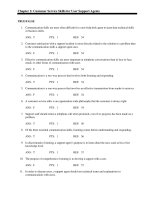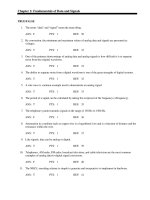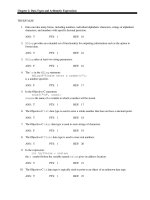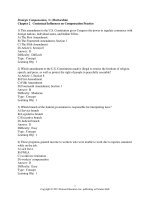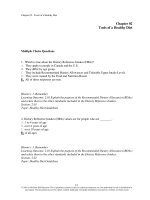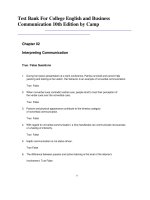Marketing for tourism hospitality and events a global and digital approach 1st edition by hudson test bank
Bạn đang xem bản rút gọn của tài liệu. Xem và tải ngay bản đầy đủ của tài liệu tại đây (220.35 KB, 5 trang )
Marketing for Tourism, Hospitality & Events: A Global & Digital Approach
1st edition by Simon Hudson, Louise Hudson Test Bank
Link full download: />Chapter 2: Understanding Today’s Consumer
1. Charie Locke is the owner of which ski resort in Canada?
a. Lake Louise
b. Banff Mount Norquay
c. Sunshine village
d. Whisteler Ans: A
2. What three aspects compose consumer behaviour analysis?
a. consumer motivations, consumer studies, and consumer patterns
b. consumer typologies, consumer motivations, and the consumer purchasing process
c. consumer patterns, consumer typologies, and the consumer purchasing process
d. consumer motivations, consumer studies, and consumer typologies Ans: B
3. Which of the following statements is accurate regarding motivations?
a. they are inner drives that cause people to take action to satisfy their needs
b. Maslow created a hierarchy to categorize motivations
c. motivations have a direct influence on consumer behavior
d. both a and c are correct Ans: D
4. Which of the following statements is NOT accurate?
a. Beliefs are ingrained feelings towards aspects of life and are more difficult to change than
attitudes
b. Factors influencing motivation and purchase include learning, beliefs and attitudes, and
perception
c. Learning is formed through past experiences which develop into a mental inventory of
expectations
d. Perception is shaped by information that people filter and then retrieve
Ans: A
5. Choosing to interpret different stimuli in different ways, often ignoring some factors while
enhancing others, is known as: a. selective distortion
b. significative stimuli
c. a mind-picture
d. selective perception Ans: D
6. How is culture transmitted?
a. mental programming
b. symbolic gestures
c. the spoken and written word
d. b and c Ans: D
7. Which of the following statement is TRUE about the senior market?
a. the senior market is tied to seasonal travel due to reduced mobility
b. involves longer trips
c. is wedded to midweek or weekend travel
d. it is not a lucrative market Ans: B
8. A recent study from the London School of Economics identified a new model of class with
seven classes. Which of the following is NOT one of them? a. elite
b. precariat
c. traditional upper class
d. traditional working class
Ans: C
9. Lifestyle analysis examines the way people allocate:
i. activities
ii. time iii.
energy iv.
money
a. i, ii, and iv only
b. ii, iii, and iv only
c. iii and iv only
d. i and ii only Ans: B
10. What is the concept of the family life cycle based on?
a. the premise that travel patterns and destinations vary as people live together
b. the premise that when people live together their way of life changes
c. the study of non-nuclear families
d. none of the above Ans: B
11. When it comes to marketing plans, the X Games is heavily weighted towards:
a. social media and online advertising
b. sponsorships
c. print advertising
d. product placements Ans: A
12. Which of the following statements is FALSE concerning Plog’s tourist motivation model?
a. Plog found that the majority of the population was psychocentric
b. psychocentrics prefer familiar destinations, packaged tours, and “touristy” areas
c. Plog’s theory has been criticized as being difficult to apply
d. it has two dimensions: allocentrism/psychocentrism and energy
Ans: A
13. Which of the following classifications of tourists was NOT proposed by Cohen? a.
the individual mass tourist
b. the drifter
c. the roamer
d. the organized mass tourist Ans: C
14. What are the three levels of commitment in the buying process?
a. truncated, extended, and habitual
b. extended problem solving, habitual problem solving, and limited problem solving
c. habitual, limited, and unlimited
d. extended, limited, and unlimited Ans: B
15. Role adoption will also influence the buying process. Which of the following is NOT one of
those roles? a. decider
b. searcher
c. initiator
d. buyer
Ans: B
16. In order to close a sale within a business-to-business market, it has been argued that the
supplier has to identify and satisfy all _______________ in the decision-making unit. a.
groups
b. deciders
c. buyers
d. stakeholders
Ans: D
17. Which of the following are trends or demands in consumer behavior that are currently
influencing tourism and hospitality marketing? a. ethical consumption
b. customization, convenience, and speed
c. wellness
d. all of the above Ans: D
18. Which of the following statements is TRUE?
a. two trends are emerging: the desire for personalized service and the desire for highly
specialized trips
b. travel agents and tour operators have been slow to react to the changing needs of customers in
regards to customization
c. requests for customized and personalized vacations are rising
d. both a and c Ans: D
19. In the case study, “Hotels Responding to ‘Bleisure’ Trend”, which of the following
companies are seen to be responding to this trend? a. Pullman
b. Westin
c. The Sanctuary
d. All of the above Ans: D
20. “Bleisure” refers to the fact that:
a. The lines between business and leisure travel are becoming increasingly distinct
b. The lines between business and leisure travel are becoming increasingly blurred
c. The lines between female business and leisure travel are becoming clearer
d. Business travelers are taking less holidays
Ans: B



